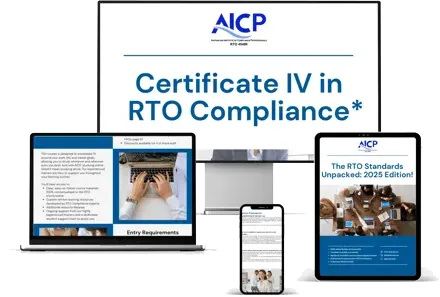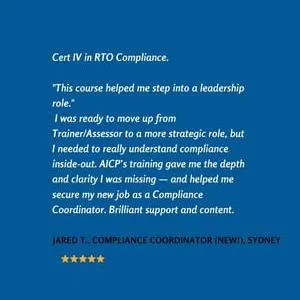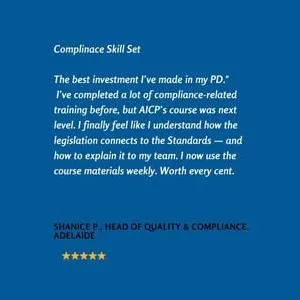Become Australia’s Most Trusted RTO Compliance Professional
Nationally Recognised Online Courses.
Real-World Support. Audit-Ready Outcomes.
Industry-Recognised Training
100% Online and Self-Paced
Trusted by hundreds of RTOs across Australia.

Compliance is complex, are you confident?
At AICP, we exist for one reason: to empower VET professionals like you with the knowledge, tools, and qualifications to lead compliance with clarity, integrity, and impact.
Whether you're new to the space or ready to formalise years of experience, our industry-leading programs are built to help you meet your obligations — and exceed them.
Built on benchmark standards
Designed for real roles, not just theory
Written by Australia’s most trusted compliance expert
Our mission is to lift the knowledge and skills across the compliance sector — one confident, capable professional at a time.
Explore our courses and step into your next chapter with credibility, confidence, and nationally recognised training that’s trusted across Australia.


Imagine running a compliant, profitable RTO you’re proud of
At AICP, we don’t just teach compliance — we help you lead it.
Our nationally recognised qualifications, professional development programs, and practical toolkits are designed to build confident, capable VET professionals at every level — from frontline staff to senior executives.
We equip you to:
Deeply understand regulatory requirements — not just what they say, but how to implement them
Apply the RTO Standards across every system, team, and operational process in your RTO
Identify and resolve non-compliance before it escalates
Approach audits with clarity, structure, and confidence — not fear
Lead teams and strategy at a senior level, with qualifications that support COO, CEO, or RTO Director responsibilities
Whether you’re working as a Compliance Officer, Administrator, Trainer, Manager, or in executive leadership — AICP gives you the tools, training, and support to strengthen performance, drive improvement, and future-proof your RTO.







